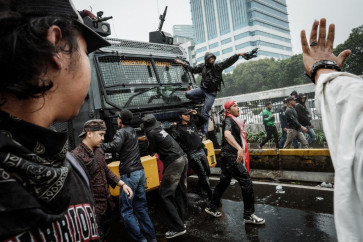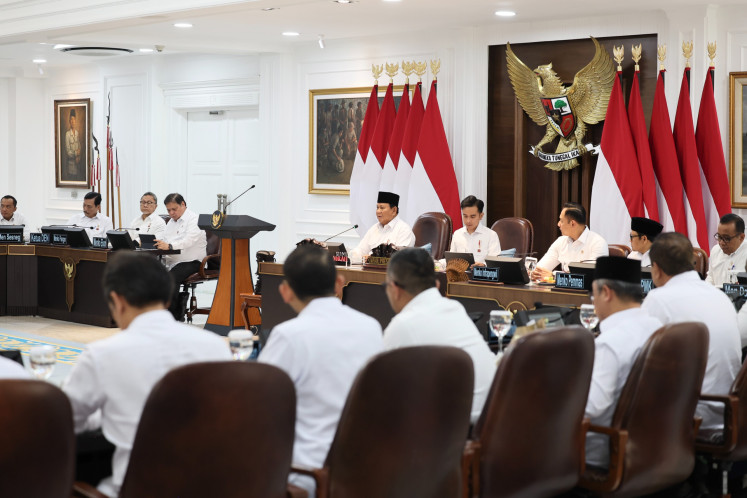Popular Reads
Top Results
Can't find what you're looking for?
View all search resultsPopular Reads
Top Results
Can't find what you're looking for?
View all search resultsLiem Sioe Liong, political power and the age of tycoons
And so Uncle Liem has gone
Change text size
Gift Premium Articles
to Anyone
A
nd so Uncle Liem has gone. For most Indonesians born before 1990, he was the most recognizable Chinese-Indonesian of the late 20th century, perhaps even more prominent than the Olympics golden couple.
While the badminton champions’ ethnicity was rarely highlighted by the media and the public, Liem Sioe Liong, aka Soedono Salim, symbolized the conflicting feelings between admiration and hatred, and between awe and envy among many Indonesians toward its largest ethnic (and religious) minority.
Liem Sioe Liong was the embodiment of the typical Chinese man, although he was certainly not the typical Chinese-Indonesian man. When he was described as a good taxpayer, he was called Soedono Salim. When he was depicted as a greedy cat, he was called Liem Sioe Liong.
Liem was, in the parlance of Chinese-Americans, fresh off the boat. He was the only Chinese-Indonesian empire builder who was born in China and developed his business in Java. His rivals, also well-known but not as close to the political power as he was, were either born in Java or started their careers on another island.
Java has been a source of wealth for centuries — certainly it is the only island in Indonesia, or indeed in Southeast Asia, capable of holding a large population and producing large agricultural output without the need of industrial engineering. Java was also the only place in Southeast Asia where an anti-European revolution took place after the end of the Pacific War. Chinese merchants needed to seek favor with the revolutionaries in order to survive. Liem was one of them.
Over the years, both the Army and the traders became adept in the arts of fulfilling each other’s needs and in securing their supply routes. Sukarno’s socialist economic policy, however, prevented these traders from building their bases in Jakarta.
When Soeharto come to power, it was the time to take the relationship to the next level. These traders had no significant objection to the anti-Chinese policies — they were anti-communists with no link to the People’s Republic of China and they flourished by adopting Javanese culture and identity.
Besides, like everything else, the ones affected by the rulings were ordinary ethnic Chinese making a living in downtown Jakarta, and not those controlling plantations and warehouses.
So the industrial boom started in the 1970s — banking, automobiles importation, textiles and food businesses. Running for the next two-and-half decades, this was the golden period that so many Indonesians remember fondly.
While other tycoons were also making headlines, Liem stood above the rest due to his close personal ties with Soeharto. Like elsewhere in Southeast Asia, a tycoon prospers thanks to the patronage of the ruling class, which needs the tycoons’ know-how in business and extensive connection with other businessmen in the region.
While indigenous tycoons such as the Bakrie and the Kalla families later managed to turn their business power into political power, the Chinese lived at the mercy and good favor of the government.
The climax came in the 1990s. This was when the term “conglomerate” became popular in Indonesian parlance. Supposedly meaning a multi-industry company, in Indonesian it refers to the Chinese leader of a conglomerate.
When people talked about conglomerates, they were referring to the Liems and the Riadys, not the Bakries or relatives of Soeharto. While Jakarta was growing into a city of malls, housing estates and five-star hotels, racing with Bangkok and Kuala Lumpur to become the next Singapore, more politicians, military officers and media openly showed hostility toward Chinese-Indonesians.
And Soedono Salim represented all bad things associated with the Chinese, not least of all because of his connection with the decreasingly popular Soeharto.
His story seemed to end with the fall of Soeharto. Western and Singaporean academics are familiar with one picture that captures the essence of the May 1998 riots – Indonesian rioters burning a portrait of Liem Sioe Liong and his wife. Along with several other Chinese-Indonesian figures, he was, and probably still is, blamed for the severe economic crisis of the late 1990s.
Just like Soeharto, he was hardly discussed in the 21st century. His heir Anthony is not as high-profile in the public arena, despite the fact that Anthony Salim is one of the richest men in Indonesia who owns major companies, such as Indofood and Bogasari, and manufactures products for multinational consumer goods companies such as Unilever, Lion Corporation and Nestle.
In fact, we don’t discuss the “conglomerates” (tycoons) the way our fathers did. When Indonesian media report on Indonesians on the Forbes billionaires list, many readers are bemused by the names. They have never heard of them, and not because these gentlemen are mysterious men. Most of us still think that the power of a tycoon comes from their political power or military connection.
Thus the more familiar names are those linked with generals or indigenous businessmen seeking the presidency. But certainly talking about the wealthy is not fashionable anymore, probably after the crash of 1997, and probably because Indonesians have realized that talking about the “conglomerates” means talking about rich Chinese, and it is no longer fun.
The media, employing the Javanese ethic of emphasizing the positive sides of the recently deceased, highlight Liem’s public image as a frugal and simple man. Many readers thank him for creating Indomie and Bank Central Asia.
Few readers will say that he will pay for his crimes in the afterlife — the crime of Bank Indonesia liquidity support (BLBI). For some Indonesians, the bailout of supposedly Chinese-owned banks through the BLBI plan was treason, since popular belief holds that the tycoons used the bailout funds to rebuild their bloodsucking empires and even to invest the money outside of Indonesia.
For his detractors, Liem is a traitor to the end, as he died in Singapore and is buried in the city-state, viewed by these people as a corrupt vault where the people’s money is stored. It certainly does not help that the majority of Singapore’s population are Chinese.
With the passing of Liem Sioe Liong, we might say that we have separated from our paradise lost, which was the Soeharto era, with its ridiculous dictatorship and comfortable living. Fewer people are optimistic about conditions and future in democracy, rule of law and prosperity in Indonesia.
How Liem lived and where he died might serve as a parable of this nation’s doomed dreams.
The writer is a graduate of La Trobe University in Melbourne, Australia.










